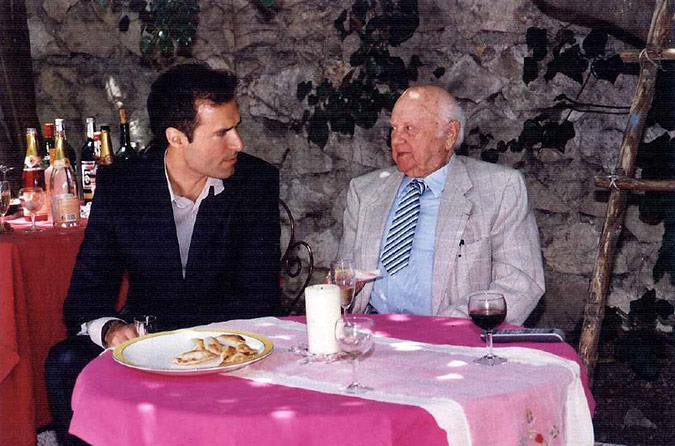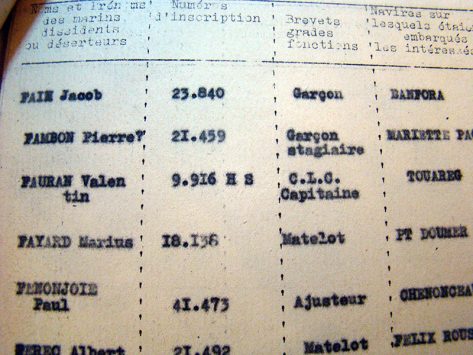
I met Marius in the early 2000s, he was my wife’s great uncle. At the time, he lived in Aix en Provence with his sister Mireille. They lived a few hundred metres from the offices where I worked. He regularly invited me to lunch and it was at the table that I began to discover the main stages of Marius’ life.
Born in 1911, he was already old and had been retired for many years. The old man had spent his life as a sailor on liners and cargo ships and had dozens of anecdotes to tell. As a trained oceanographer and maritime archaeologist, I enjoyed Marius’ stories. In the family, they were of no interest to anyone but me and I found it regrettable that the memories of this fantastic life would one day disappear with him.
One of the most fascinating stories he told me was about the liner “Président Doumer” on which he had sailed and with which he had been shipwrecked during the Second World War. At that time, after having sailed on different ships, mainly as a bosco, Marius was taken on board this French luxury liner of the Messageries Maritimes company, launched in 1933 in La Ciotat. Assigned to the Far East line, the “Président Doumer” carried wealthy passengers to Asia, mainly from Marseille. Initially with a black hull, then completely repainted in white in 1938, she is about 150 m long and can sail at up to 19 knots. She belongs to the class of nautonaphtes. When the war broke out on 3 September 1939, the liner, with Marius on board, was in Colombo (Ceylon). She returned to Marseille and was placed at the disposal of the French Navy. She is armed with machine guns and cannons and sails as a troop carrier. The ship and her crew were decorated, notably during the famous battle of Narvik (Norway) in June 1940. When France surrendered in July, Marius was in Port Said (Egypt) with the liner. The city is held by the British who requisition the “Doumer” and leave the crew the choice to return to Pétain’s France or to stay on board. Marius and some sailors choose to desert and fight on the side of the British.

The ship is now under the British flag before joining the famous Forces Françaises Navales Libres (FNFL). The former luxury liner often sails alone. It carried troops and goods to various fronts (South Africa, Turkey, Iran, etc.). “It was an adventure”, Marius tells me.
In the autumn of 1942, from Durban, President Doumer had to sail to Liverpool to enter a refit. At the port of call in Freetown, Sierra Leone, the ship was assigned to a convoy of 42 ships that had to sail back to England. It was 17 October and the ships were due to sail a few days later. According to Marius, this mission seems to have been improvised at the last minute. More suspicious, he says, during the crossing, the convoy leaves almost without escort (only 2 corvettes for 45 boats) and the staff imposes to the convoy an extremely low speed (between 6 and 9 knots against 14 or 15 usually)… These conditions are unusual and worry a lot the crew of the “Doumer”… it is the tragedy of the SL 125 which is preparing!
Still according to Marius, what had to happen… happened! On 30 October 1942, after having witnessed the torpedoing of many other ships, the “Président Doumer” was torpedoed by the German submarine U 604 and sank in a few minutes off Madeira, causing the death of several hundred people. For the survivors, the trauma is immense. Marius tells me that from the submarine, the German soldiers continued to machine-gun the survivors who were struggling in the oily water. Along with about 100 survivors, Marius is picked up by another ship in the convoy, the SS Alaska. Hit by a torpedo, it managed to reach Gibraltar…
With eleven ships sunk, convoy SL 125 finally arrived in Liverpool a few days later. To his great surprise, the ‘Commodore’ of the convoy was congratulated by the general staff… In his memoirs, the great Winston Churchill referred to convoy SL 125 as an ‘acceptable accident’ because of its many losses!
Marius died in 2008 and since then this story has haunted and fascinated me. After some research, I realised that this event was almost unknown and that no historian seemed to have given it any importance! Where is “President Doumer”? Was he sacrificed to let the hundreds of ships of Operation Torch through? How could they cross the Atlantic without being attacked by any submarine and without being spotted? Incredible! These are the questions that Marius had been asking himself all his life and to which I have to answer today !
In October, it will be 80 years since the Doumer sank! For Marius, for all these sailors, for France, we must find funding to carry out the investigation!
If we manage to shoot this documentary, write this book and solve this enigma, maybe then we will go and look for the wreck… According to the position of the last SOS of the ship, it probably lies north of Madeira, on the slopes of an underwater volcano, between 3000 and 4000 metres deep… the same depth as the Titanic !!!

